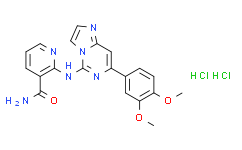| Cas No.: | 648903-57-5 |
| Chemical Name: | 3-Pyridinecarboxamide,2-[[7-(3,4-dimethoxyphenyl)imidazo[1,2-c]pyrimidin-5-yl]amino]-,dihydrochloride |
| Synonyms: | 3-Pyridinecarboxamide,2-[[7-(3,4-dimethoxyphenyl)imidazo[1,2-c]pyrimidin-5-yl]amino]-,dihydrochloride;2-[[7-(3,4-dimethoxyphenyl)imidazo[1,2-c]pyrimidin-5-yl]amino]pyridine-3-carboxamide,dihydrochloride;BAY 61-3606;BAY 61-3606 (dihydrochloride);BAY61-3606 dihydrochloride;BAY-61-3606;96PPV9GQ7A;2-((7-(3,4-Dimethoxyphenyl)imidazo[1,2-c]pyrimidin-5-yl)amino)nicotinamide dihydrochloride;C20H18N6O3.2ClH;HMS3746I13;BCP24726;3472AH;s7006;2-(7-(3,4-Dimethoxyphe;BAY 61-3606 dihydrochloride;2-(2-furanyl)benzonitrile;2-(2-Furyl)benzonitrile;648903-57-5 (HCl);BAY 61-3606 2HCl;BAY 61-3606 (dihydrochloride);BAY61-3606 dihydrochloride;BAY 61-3606;BAY 61-3606 hydrochloride;BAY 61-3606(dihydrochloride);bay 61-3606(hcl);BAY-613606;bay-61-3606 2hcl;BAY61-3606 dihydrochloride;BAY 61-3606;http:////www.amadischem.com/proen/548662/;http:////www.amadischem.com/proen/571789/ |
| SMILES: | O=C(N)C1C(NC2N3C=CN=C3C=C(C3C=C(OC)C(OC)=CC=3)N=2)=NC=CC=1.[H]Cl.[H]Cl |
| Formula: | C20H20Cl2N6O3 |
| M.Wt: | 463.31720161438 |
| Sotrage: | 2 years -20°C Powder, 2 weeks 4°C in DMSO, 6 months -80°C in DMSO |
| Description: | BAY 61-3606 (dihydrochloride) is a potent, ATP-competitive, reversible, and highly selective inhibitor of Syk tyrosine kinase (IC50=10 nM) with no inhibitory effect on Btk, Fyn, Itk, Lyn, and Src. |
| In Vivo: | BAY 61-3606 (3, 10, 30, 100 mg/kg, p.o.) dose dependently inhibits the PCA reaction with an ED50 value of 8 mg/kg. In a bronchoconstriction model, BAY 61-3606 dose dependently inhibits the DNP-BSA-induced increase in pulmonary pressure, and the dose of 3 mg/kg shows statistically significant suppression[1]. |
| In Vitro: | BAY 61-3606 inhibits the release of various inflammatory mediators in a concentration-dependent manner. The IC50 values for the FcϵRI-mediated hexosaminidase release from a rat basophilic leukemia cell line, RBL-2H3, and serotonin release from rat peritoneal mast cells are found to be 46 and 17 nM, respectively. BAY 61-3606 inhibits FcϵRI-mediated histamine and tryptase release from HCMCs with IC50 values of 5.1 and 5.5 nM, respectively, in a manner similar to its effect on the degranulation of RBL-2H3 cells and rat peritoneal mast cells. BAY 61-3606 inhibits histamine release from leukocytes in high and low IgE groups equipotently, giving IC50 values of 8.1 and 10 nM, respectively[1]. BAY 61-3606 affects viability in cells expressing mutant K-RAS or B-RAF through a MAPK-independent pathway. Inhibition of SYK is not responsible for the BAY 61-3606 effect on cell viability in colorectal cancer cells. MAP4K2 is a target for BAY 61-3606 that modulates the response of wild-type cells to AZ-628[2]. BAY61-3606 has a 50% Cytotoxicity Concentration (CC50) value of greater than 100 μM, and it inhibits AD169 replication[3]. |

 DC Chemicals' products qualify for U.S. tariff exemptions. We guarantee no price increases due to customs duties and maintain stable supply, continuing to deliver reliable research solutions to our American clients.
DC Chemicals' products qualify for U.S. tariff exemptions. We guarantee no price increases due to customs duties and maintain stable supply, continuing to deliver reliable research solutions to our American clients.





















